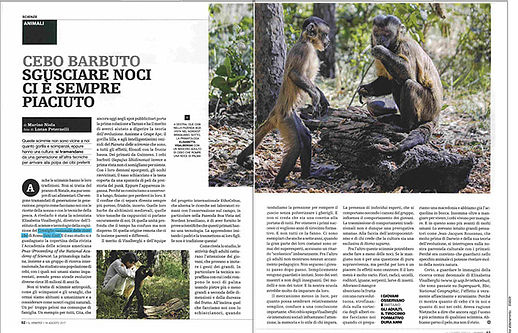
MONKEY CULTURE AT RISK
Scientific documentary
October, 2020

SUPERQUARK - LA "CULTURA" DEI CEBI
RAI1
July, 2020
Excerpt within the episode of the programme Superquark broadcaster on 29 July 2020 on Rai1
Watch the excerpt

QUALCOSA SI È ROTTO
La7
Backstage
April, 2020

SUPERQUARK +
Episode 9 - "L'amore"
December, 2019

CAPUCHIN CULTURE
Short documentary
September, 2019
Producer and Director: Luca Antonio Marino
Executive Producers: Fraser Durie, Fiona Pitcher, Philip James
Watch the film
See the Facebook page

WILD ROME
Short documentary
May, 2019
Producer and Director: Luca Antonio Marino
Executive Producers: Fraser Durie, Fiona Pitcher
Watch the film

American Scientist
July, 2018
.

Il Venerdì di Repubblica
September 11, 2017
.

Proceedings of the National Academy of Science of the United States of America
Cover image
July 25, 2017
See the web page

New Scientist | The Collection
Wild Planet
Opening image
October, 2016
.

Science Illustrated
Double-page spread photo
May, 2016
.

Focus
February, 2016
.

The Royal Society Publishing, Philosophical Transactions B
Cover image
November, 2015
In Fazenda Boa Vista (Piauí, Brazil), wild bearded capuchin monkeys (Sapajus libidinosus) habitually use percussive tools. This alpha male, weighing 4.2 kg, uses a 3.5 kg stone tool to crack a very resistant piassava nut.
See the website

Marine litter in the wake
Photo report
Within the network that monitors, in the Mediterranean sea, cetaceans and their associated threats, a protocol was developed to compute marine macrolitter according to the needs of the EU Marine Strategy (MSFD) and Barcelona Convention Ecosystem Approach (EcAp). Floating macrolitter is a pertinent indicator to assess if measures are successful in reducing waste ending in the sea. The photos were shot during the surveys in the Adriatic sea and hopefully a travelling exhibition will come soon.
See the website

90 days with capuchin monkeys
Photo report
A photo report documenting 90 days spent observing a group of capuchin monkeys (Sapajus libidinosus) in the forest of Fazenda Boa Vista (Piauì, Brazil). The pictures give an overview of the life and habits of these monkeys, showing their behaviors and the environment where they spend their time.
Capuchins' special skills, rich social life and their deep expressions make them a perfect subject for a photographer aiming to document wildlife and, at the same time, convey emotions through the camera lens.

The Bearded Capuchin Monkeys of Fazenda Boa Vista
Assistant to editing and writing
A scientific documentary by Elisabetta Visalberghi and Alessandro Albani.
This DVD illustrates the research carried out by an international team (see www.ethocebus.net) on the behavior of wild tool using bearded capuchin monkeys that live in Fazenda Boa Vista (Gilbués, Piauí State, Brazil). The DVD is appealing to a large audience and scientifically rigorous.
The DVD provides a general overview of the ecology and behavior of this population. It is organized in five chapters: The ecology of wild capuchins, Stone tool use, Infant care and social behavior, Feeding and foraging activities and Becoming proficient foragers.
There are three extra chapters. Early days illustrates the beginning of the research. Field experiments on tool use illustrates some of the innovative procedures carried out to investigate stone tool use. Humans and environment provides information about the people living in this area and the threat of deforestation and intensive agriculture to capuchins’ survival.
To have the DVD contact elisabetta.visalberghi@gmail.com
Funds raised with the DVD will be used to support research, education and conservation
activities.









